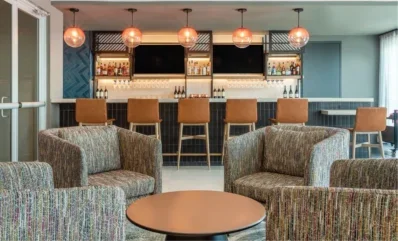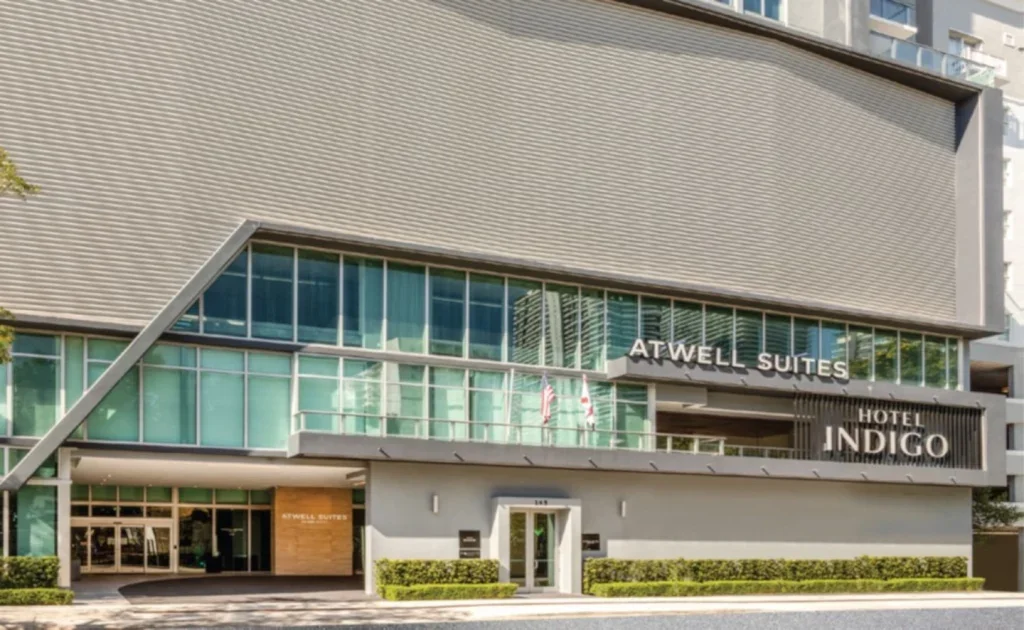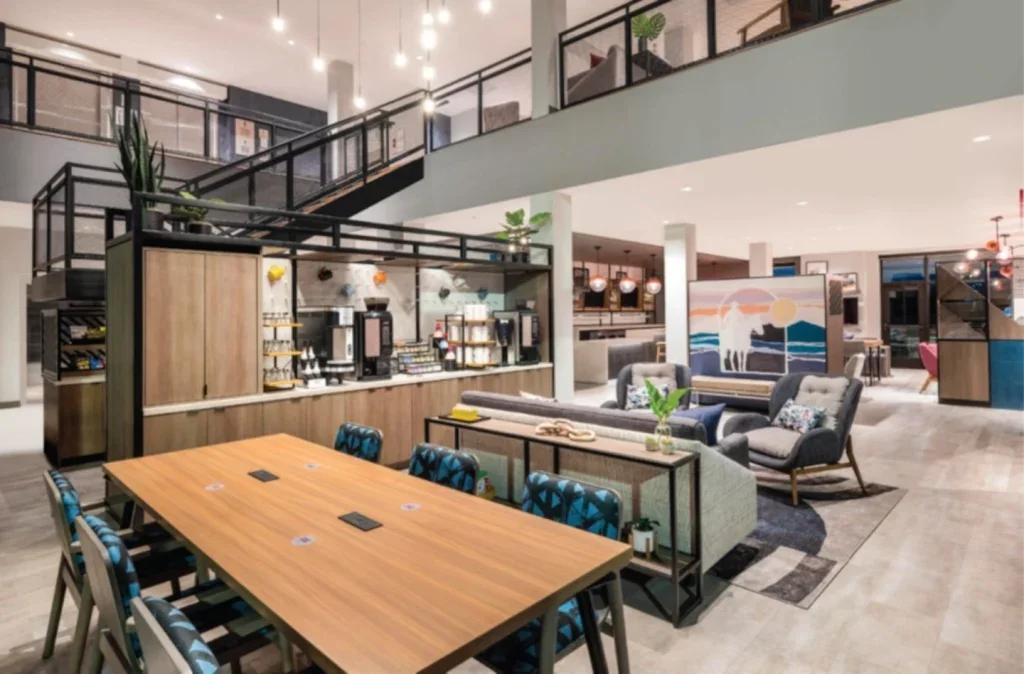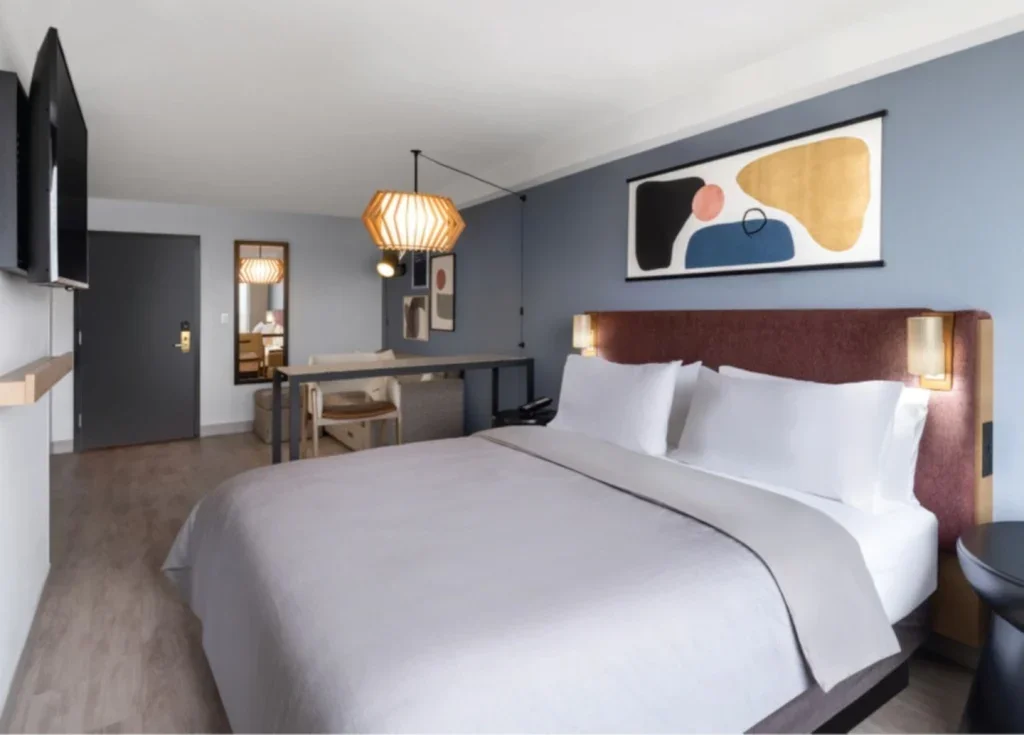
In 1962, passengers from Idlewild Airport would have noticed something new. The brainchild of Finnish architect Eero Saarinen, the TWA Flight Center was modernism made concrete, its innovative shell design and green-glass facade symbolic of the jet age in all its enthusiasm. The architect himself compared the building’s bird-like design to a “Leonardo da Vinci flying machine” – and it’s hard to disagree, its soaring white roof as dramatic as anything conjured by Saarinen’s renaissance forebear.
Though widely regarded as his finest design, Saarinen himself would never see the TWA Flight Center open, sadly passing away in 1961. Idlewild Airport has passed into history too, renamed JFK after the president’s assassination. Nor would the TWA Flight Center really stand the test of time, closing in 2001 and amiably rotting as aircraft came and went. Now, though, Saarinen’s masterpiece has been revived in the most unlikely of guises: an airport hotel. Foregoing all the unfortunate clichés that title implies, Time described the new TWA Hotel as one of the ‘greatest places’ on Earth when it opened in 2019, reasonable enough when you recall the glamorous cocktail lounge or heated swimming pool.
Nor is Saarinen’s reborn showpiece alone. From Singapore to Texas, hotel operators are rushing ahead with a new generation of airport hotels, like the TWA offering passengers lashing of luxury alongside aircraftside convenience.
That’s shadowed by a range of new features, from barroom games to study rooms to fitness centres. At their most ambitious, hotel executives hope that their airport hotels can transcend their reputation for utilitarianism, instead creating properties that are places to enjoy – rather than simply silos to meet or sleep before heading back to the terminal.
Flying high
Airport hotels are soaring. That’s obvious enough if you examine the numbers, with Heathrow alone enjoying a pipeline of more than 2,000 rooms. It’s a similar story across the Atlantic: work by CBRE has found that RevPAR at airport hotels in the US increased by 4.4% in May 2024. This sector growth is equally reflected at the brand level, with Hilton and Radisson just two of the companies to announce ambitious airport hotel plans. A third brand enjoying a similar trajectory is Atwell Suites. An upper-midscale chain, this IHG imprint has a pipeline of some 40 airport properties – alongside the three already open.
How to explain this growth? For Karen Gilbride, the answer partly lies in what’s always made these properties attractive. “Airport hotels have served – and will always serve – a critical need in our industry and for travellers in every corner of the world,” says Gilbride, a VP for several IHG brands, including Atwell Suites. “Today’s travellers want reliability and consistency, but also spaces and amenities that cater to their flexible work schedules and styles. Airport hotels fill gaps as convenient, go-to destinations for quick meetings or get-togethers, especially for travellers quickly passing through one place on their way to another.”
Fair enough: with IATA reporting that more than 70% of flyers value proximity to the airport when choosing their departure point, it makes sense that many plump for nearby hotels. Yet if early morning check-ins explain much of the airport hotel’s appeal, Gilbride’s reference to “spaces and amenities” hint at a change of strategy. For where these places were once holding pens for family getaways, or else mere conference centres with bedrooms attached, places like the TWA Hotel clearly show much greater ambition. As so often in the hospitality space, moreover, customers themselves are pushing these changes along, with polls as far back as 2016 showing that guests valued ‘luxury’ and ‘innovation’ when booking a night at the airport. Whatever the cause, at any rate, it’s obvious that consumer demand is transforming what airport hotels involve. Apart from the TWA’s runway-side pool, that’s apparent enough in places like the Crowne Plaza Changi Airport. Voted Skytrax’s best airport hotel on Earth in 2023, this Singapore hotel has everything from fine Italian dining to a landscaped swimming pool. And while Atwell Suites aren’t in quite the same league, Gilbride nonetheless emphasises that her properties offer a “design-led alternative” to dreary airport stereotypes, with fitness studios and spa-like bathrooms coming as standard.

Hosting in Austin
At first glance, Austin-Bergstrom International Airport is not the place you’d expect to enjoy a first-class hotel experience. Flanked by the highways and stripmalls of the Texan capital, this is a place that exudes Americana in all its mundaneness. But flanked by a data centre on one side, and a Denny’s on the other, is the Atwell Suites Austin Airport – and if you step through the glass-fronted doors, everything changes. Throwing off the industrial sameness of most airport hotels, this is a property with real character. Consider the public spaces, all trendy carpets and smart wooden chairs, or else the garden with its oblong swimming pool. It’s a similar story in the 85 guest rooms, with suites boasting handsome abstract paintings and off-beat light fixtures.
2,000+
The current room pipeline for Heathrow Airport.
geraldeve.com

Beyond the headline impression, meanwhile, it’s plain that the Atwell Suites Austin Airport typifies a new kind of airport hotel in other ways. When it comes to dining, for instance, Gilbride highlights the graband- go options and bean-to-cup coffee – as well as the usual complimentary breakfasts. For guests wanting to eat in private, each suite also comes with a fridge, microwave and sink. The Atwell’s bar is different too: apart from the wine, and the ready-to-drink cocktails, there are also puzzles and ‘conversation starter coasters’ for guests who want to make friends before their flight. That last point is worth considering in more detail. For if Atwell Suites doubtless upgrade the standard airport hotel experience, Gilbride and her colleagues equally haven’t forgotten the aircraft buzzing overhead. With that in mind, many of the Austin hotel’s features gesture towards making the property suitable to transient visitors. To explain what she means, Gilbride returns to the question of dining, explaining how her team partly offers such a variety of food precisely because certain “airport markets have limited restaurant options, and guests may not wish to drive far or order a ride to get a drink or quick bite after a long day”.

As details like the starter coasters imply, meanwhile, the IHG executive is conscious that travel can be disorienting – and guests may seek kinship after hours alone in a window seat. “Travel opens doors for community and kinship,” she says, “and we’ve designed our Atwell Suites properties to inspire guests to discover more about each other and the local area. Everyone’s travel story is different. Maybe one of our guests has not spoken to many others during a long travel day. Someone else could be travelling in a different time zone and unable to connect with their friends or family.”
71%
The percentage of passengers who value closeness to the airport when choosing their departure point.
timesaerospace.aero
To accommodate the human jetsam an airport inevitably accrues, Atwell properties are therefore built to allow for both privacy and partying. If, for instance, a business guest wants to work in silence, they can retreat to a small study room to take a call. If, on the other hand, they’d rather tap on their laptop with colleagues, the hotel’s two-storey lobbies feature flexible seating arrangements. Conscious, perhaps, of the workpattern changes wrought by the pandemic, Atwell also brings something of the co-working ethos to its properties. “We’ve seen guests gravitate towards our complimentary beverage areas as workstations,” says Gilbride, “much as they would at their favourite local coffee shop.”
Terminal velocity
Combined with other features – not least the ability to cast from laptops to in-suite TVs – and Gilbride is unsurprisingly convincing a range of customers to stay at her hotels. “We’re encouraged,” she says, “by the mix of guests – traditional longer-stay travellers, but also transient, corporate and group visitors – open to experiencing all that Atwell Suites has to offer.” That chimes with the sector at large. In 2023, to give one example, London airport hotel occupancy hit 84%. Four percent higher than the Greater London rate of 80%, it implies that Atwell Suites isn’t the only brand to boost its marketability.
Not that Gilbride is resting on her laurels. Apart from that double-figure pipeline, she’s eager to stay in close contact with owners: the people who, alongside guests, ultimately understand “the opportunities” the extended stay and suites space offers. It surely helps that air travel looks destined to dominate global travel even more than it already does. In the UK alone, an extra 127.5 million travellers will visit through 2040, even as the number of short-haul passengers could jump by almost 90 million.
Once you factor in the airport boom in developing countries – China could have 400 civilian transport airports by the end of 2035 – and Gilbride is optimistic for the future of her brand. “Travel demand remains strong,” she says, “and the industry has proven its resiliency in recent years. It’s hard to find a major city airport that isn’t under construction or renovating to accommodate additional traffic and changing traveller needs.” A fair point – and one Saarinen would surely be thrilled to hear.






